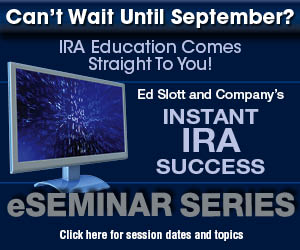 Recently, we wrote about potential tax advantages available to individuals who receive lump sum distributions from employer-sponsored qualified retirement plans. On March 27, 2012 we detailed specifics regarding the concept of “Net Unrealized Appreciation” applicable to the in-kind distribution of employer securities, and we also wrote an article titled, “What You Need to Know about Special 10 Year Income Averaging.” Both articles confirmed that to qualify for either one of these provisions a lump-sum distribution must be received in one taxable year. This has prompted many questions on how lump-sum distributions are reported and taxed on an individual’s income tax return.
Recently, we wrote about potential tax advantages available to individuals who receive lump sum distributions from employer-sponsored qualified retirement plans. On March 27, 2012 we detailed specifics regarding the concept of “Net Unrealized Appreciation” applicable to the in-kind distribution of employer securities, and we also wrote an article titled, “What You Need to Know about Special 10 Year Income Averaging.” Both articles confirmed that to qualify for either one of these provisions a lump-sum distribution must be received in one taxable year. This has prompted many questions on how lump-sum distributions are reported and taxed on an individual’s income tax return.
Generally, company plan distributions are reported directly on Form 1040 (the personal tax return) and are part of adjusted gross income (AGI). This generally includes the taxable portion of an NUA distribution. However, other lump-sum distributions are not part of AGI. They are reported and taxed separately on Form 4972, “Tax on Lump-Sum Distributions.”
Most tax benefits, deductions and credits are based on AGI. By excluding the lump-sum distribution income from this category, AGI will be lower and the taxpayer will hopefully qualify for more AGI-based tax benefits.
A plan participant who receives an eligible lump-sum distribution from a qualified retirement plan during 2011 will need to file Form 4972 with their 2011 tax return in order to receive special tax treatment. This form is also used for beneficiaries who receive the lump-sum distribution from the plan of a deceased plan participant, but only if the decedent they inherited from would have qualified for the special tax treatment had he or she lived (except for the “5 year plan participation rule” applicable to 10 year income averaging that applies only if payment is made to the participant.) This form is never used for IRA distributions because they don’t qualify for these special tax provisions.
The tax rate schedule for 10 year income averaging can be found in the instructions for Form 4972. Unfortunately, you can’t spread the tax payment over ten years. The tax is calculated (using the single filer tax rates in effect for 1986) as if payments were made over a ten year period, but it has to be paid completely for the year in which the distribution occurs.
Further, there is no such thing as a joint Form 4972. If both members of a married couple (filing jointly) elect lump-sum distribution treatment in the same year, each must complete their own Form 4972 and file it with their joint return.
As you can see, quite a lot is entailed in actually realizing tax benefits from a qualified lump-sum distribution. For most, enlisting the services of an expertly trained financial advisor who can help evaluate the merits of electing lump-sum distribution treatment and assist in navigating through the process is imperative.
-By Marvin Rotenberg and Jared Trexler
Reporting Lump-Sum Distributions
Mailbag
Thursday's Slott Report Mailbag

Consumers: Send in Your Questions to [email protected]
Q:
I transferred a stock from my IRA to my regular (non IRA account) and then transferred the exact same number of shares of the same stock back into my IRA within 60 days. However, the value of those shares was $10,000 higher.
Do I have a problem because I put more money into the IRA even though I transferred the same number of shares?
Thanks
Mark
A:
There is no problem. Your distribution of property (shares of stock) from your IRA qualifies to be rolled over tax-free within 60 days only if the identical stock is rolled over to a receiving IRA. It is common for the value of stock to change during the 60-day window. That’s OK and still qualifies as a tax-free rollover. When your tax return is filed for the year, your tax preparer may want to attach a note to explain the different values.



 Articles That Move
Articles That Move







0 comments:
Post a Comment